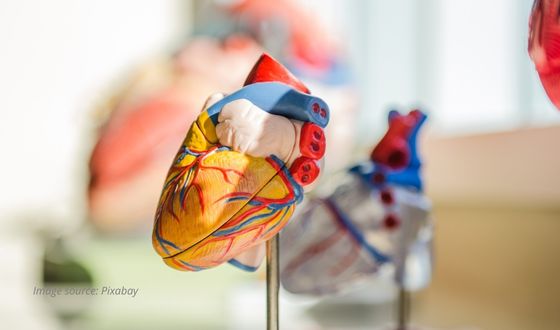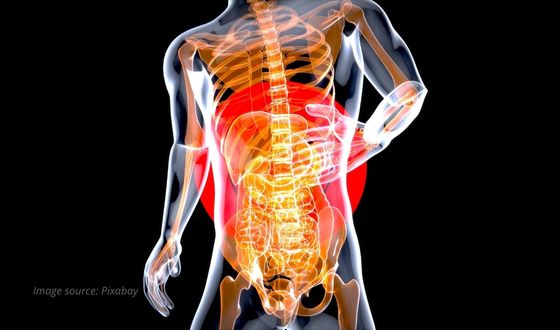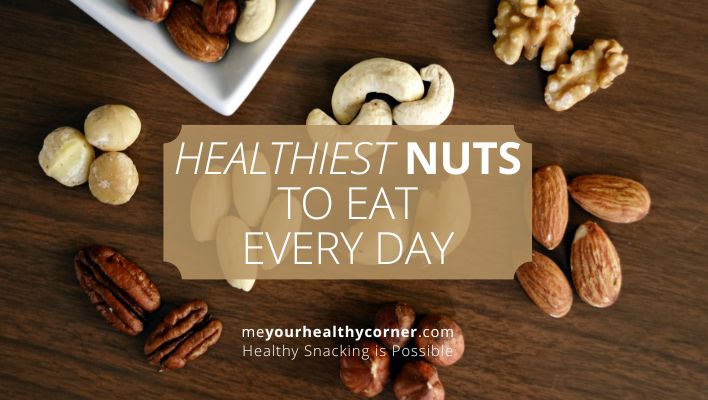Very often I come across articles or blog posts about the benefits of eating nuts. Although I’ve written and shared several posts on the health benefits of eating certain nuts, I like to compile a list, of what’s the healthiest nuts to eat so that it’s easier for you to refer to.
In case you want to read specifically on certain nuts, I’ll link them as I go.
Firstly and briefly, …
Why Are Nuts Good For Your Health
Nuts are one of the best sources of plant protein, and rich in healthy fats, vitamins and minerals, fibre plus various nutrients your body needs for better health.
You might like to know, American Heart Association listed 16 plant-based protein sources that are easily available at grocery stores. Nuts are one of them, including beans, lentils, seaweed and spinach among others.
Nuts ranked no. 5 in the Top 10 Plant-based Sources of Protein published on Everyday Health.
Depending on individual health, one may need more of certain nutrients than the other. You can easily include nuts in your daily diet according to your needs. It is a good option.

Nuts have various flavours, textures and nutrients profile. So, continue reading as I’ll share how your body benefits from eating nuts. And, find out which is best for you.
Healthy Nuts Eat List
Each type of nut provides different nutritional benefits and here are the 10 healthy nuts eat list, summarised for your easy reference. Note that this is in no particular order except alphabetically.
The chart below shows the calorie content, protein, fibre and fats breakdown into saturated and unsaturated based on a 30g serving.
| Nuts | Calories | Protein (g) | Fibre (g) | Total Fat (g) | Unsaturated Fat (%) | Saturated Fat (g) |
| Almonds | 164 | 6 | 3.5 | 14 | 92 | 1.1 |
| Brazil Nuts | 187 | 4.1 | 2.1 | 19 | 75 | 4.6 |
| Cashews | 157 | 5.2 | 0.9 | 12 | 88 | 2.2 |
| Chestnuts | 60 | 0.7 | 2.3 | 0.6 | 80 | 0.1 |
| Hazelnuts | 178 | 4.2 | 2.8 | 17 | 93 | 1.3 |
| Macadamia | 204 | 2.2 | 2.4 | 21 | 83 | 3.4 |
| Peanuts | 161 | 7.3 | 2.4 | 14 | 87 | 1.8 |
| Pecans | 196 | 2.6 | 2.7 | 20 | 91 | 1.8 |
| Pistachios | 159 | 5.7 | 3 | 13 | 86 | 1.7 |
| Walnuts | 185 | 4.3 | 1.9 | 18 | 90 | 1.7 |
Note: Unsaturated fat is liquid at room temperature and is considered good fat. Whereas, saturated fat is solid and less healthful.
From the above, you can see that chestnut is by far the lowest in calories and fats. Macadamia nuts though are on the other side of the scale. Followed by pecans, slightly lower than macadamia.
Briefly – about peanuts

Noticeably high in protein is peanuts. Did you know peanuts are a source of complete protein? And what does this mean? Simply explained,
Complete protein or whole protein contains all nine essential amino acids your body can’t produce on its own. Amino acids are compounds that play many vital roles in your body including building proteins, hormones, and neurotransmitters.
Animal-based food tends to be a good source of complete protein but if you’re looking at plant-based, the peanut is a good choice. Others would be soybeans, chia seeds, Spirulina, tempeh and quinoa.
The fact: Peanut is not a nut. Yup, peanuts are not true nuts but a legume belongs to the botanical family known as peas and beans.
Now, let’s proceed to the next…
Healthiest Nuts to Eat Every Day
There are several reasons for increasing health problems and today’s modern living is one of the causes.
Lifestyle factors such as high stress, unhealthy diet or poor nutrition, lack of sleep, alcohol and tobacco consumption, and environmental quality among others lead to many health issues. The most prominent is cardiovascular disease which is heart and blood vessels related. Obesity is closely related to heart disease too,
Apart from the busy lifestyle, ageing is another area of concern where brain health and bone health are as important to manage.
Now, you’re about to find out what nuts are good for…
1. Heart Health

Regular consumption of nuts may lower unhealthy cholesterol levels, lower the risk of high blood pressure and reduce the risk of blood clots. These are the contributing factors to heart problems.
Most nuts contain unsaturated fats. Referring to the healthy nuts eat list above, almonds, hazelnuts, pecans and walnuts contain at least 90% unsaturated fats based on a 28g serving.
A journal published in the National Library of Medicine states unsaturated fatty acids significantly reduce total and LDL “bad” cholesterol and modestly lowers coronary heart disease risk. (1)
Walnuts are a good source of omega-3, a type of fatty acid called alpha-linolenic acid (ALA). In observational studies, higher ALA exposure is associated with a moderately lower risk of heart disease. (2)
High blood pressure, also called hypertension is blood pressure higher than normal and can cause heart attack, stroke and other serious heart problems. Unsaturated fats in nuts, together with minerals such as magnesium and potassium, fibre, antioxidants, and vitamins are beneficial compounds in managing blood pressure. (3)
2. Weight Control
Nuts are high in calories and fat so how is it helping in weight loss?
As mentioned above, most fats are unsaturated. In this case, consuming a small portion of nuts, high in calories and healthy fats, gives you a good amount of concentrated energy.
Together with the high fibre content, snacking on nuts make you feel fuller longer.
A controlled trial showed almonds provide post-ingestive metabolic and appetitive benefits and did not increase the risk for weight gain. In simpler words, snacking on almonds helped reduce hunger and cravings. (1)
In another study, 200 participants ate peanuts as a snack and at meal times. It resulted in them eating fewer calories later in the day. The effect was much better with peanuts eaten as a snack rather than at meal times. (2)
Pistachio nuts were also used in a study in finding their effect on body weight. Participants consumed either pistachios or pretzels as an afternoon snack. After 12 weeks, there were significant changes in body mass index between the 2 groups. The result showed eating pistachio nuts does not cause weight gain. On top of that, pistachios may have beneficial effects on triglycerides as well. (3)
Note: High triglycerides increase the risk of stroke, heart attack and heart disease.
3. Brain Health

It is natural to lose some of the brain function as you age. Honestly, my memory is not as good as years ago I don’t deny it.
Natural occurrences you and I can’t change but dietary and lifestyle choices we can make.
Walnuts are probably one of the most studied nuts for brain health. (1, 2, 3, 4, 5)
Walnuts are among the richest in the vegetable omega-3 fatty acid (ALA) and it is shown to improve cognitive performance in adults and prevent or improve age-related cognitive decline. High in fibre, combined with vitamins, minerals, and other bioactive compounds, walnuts are capable of improving brain health. (6)
Besides walnuts, almonds and hazelnuts have been found in manuscripts of traditional Persian medicine as preventive agents against memory loss. These 3 nuts are recommended for their brain-protective activity. The therapeutical statements mentioned in the Persian scholars’ books are based on their clinical observations with support of a long history of experiences. (7)
I know there is a lot of reading to this point but some information here is good to know. Hope you’ll continue…
You must know, adequate vitamin E levels are essential for the body to function normally. Vitamin E is an antioxidant and you need it to protect your cells from oxidative stress. How does it affect brain health?
Oxidative stress most often leads to chronic inflammation. On top of that, as mentioned in this journal article, oxidative stress has been linked to several neurological diseases including Parkinson’s disease, Alzheimer’s disease, depression, and memory loss.
In a controlled trial, it was documented that high amounts of vitamin E can help people with mild to moderate Alzheimer’s disease. Vitamin E can benefit the mind and memory of older people by slowing their functional decline. (8)
Among all the nuts mentioned, almonds and hazelnuts have the most concentrated sources of vitamin E.
Based on a 28g serving, almonds provide 44% Daily Value (DV)* of Vitamin E and hazelnuts, 28%.
4. Bone Health
Calcium is the most important mineral for bone health. Thus, it is vital to consume calcium day-to-day to protect the bone structure and strength.
Here is an interesting point I found while researching for this post.
Absorption of calcium from food is about 45% at intakes of 200 mg/day but only 15% when intakes are higher than 2,000 mg/day. (1)
Therefore, this is why you should spread your calcium intake throughout the day. Try including high-calcium food at each meal or snack time.
Aside from calcium, magnesium and phosphorus are important for bone health too.
From nutrition data, almonds top the list being highest in calcium, followed by brazil nuts. Both contain a good amount of magnesium and phosphorus.

Here is the breakdown based on a 28g serving.
| Nuts | Calcium (mg) | Magnesium (mg) | Phosphorus (mg) |
| Almonds | 74.6 (7% DV) | 75.7 (19% DV) | 137 (14% DV) |
| Brazil Nuts | 45.2 (5% DV) | 106 (27% DV) | 205 (20% DV |
5. Gut Health

In this modern world, the fast-paced environment can affect your body negatively without you realising it.
Unintentional weight fluctuation, digestive problems such as gas and stomach bloating, moodiness, anxiety, fatigue and poor sleep quality among others are many of the effects. All these might simply be caused by one issue which is gut health.
To keep your gut healthy, you’ll have to eat healthy to feed the good gut bacteria.
Scientifically, there is a lots to say (learn) about gut health – gut bacteria, gut flora, microbiome, microbiota and so on. I’ve read but I’ll skip this part and go straight to the type of nuts for gut health.
You would have probably known that consuming high-fibre food is good for your digestive health, especially for constipation. While this is true, fibre is also necessary for good bacteria in your gut to thrive. (1)
If you refer to the list of nuts above, almonds come first with 3.5g of fibre per 28g serving. Following closely behind are pistachios at 3g and hazelnuts at 2.8g.
In brief, nuts that help you poop are most likely to be almonds, pistachios and hazelnuts. But the basis is always about taking care of your gut. Eating nutrient-rich foods and exercising regularly are the main ingredients to maintain a healthy gut.
Remember to feed the good bacteria and the bacteria will take good care of your gut, subsequently, your overall health. It all starts with what you eat.
How Much Nuts Should I Eat A Day
So far in this post, you’ve been reading a lot about the health reasons for consuming nuts. However, you must know that eating too much of anything can be bad for your health.
High in calories, nuts consumed in large amounts throughout the day can cause weight gain. And even though the fat content is mostly healthy unsaturated fats, too much in excess can cause undesirable health issues.
Snacking on nuts can easily lead to overeating, especially so with the salted version. Tasty, yes? Beware of the sodium content! It’s best to read the food label to see how much sodium is in the serving. Dry or lightly roasted nuts are a healthier choice.
The recommended serving of nuts per day ranges from 28-40g depending on which country you’re in. (1, 2, 3)
You may not need to follow the above specific nuts to eat according to their nutrient profile or benefits. This is because they have mostly similar nutrient content just in varied amounts. It’s better to eat a variety to gain various nutrients in approximately 30g per day.
Here is roughly the number of nuts in 30g:
- 20 Almonds
- 10 Brazil Nuts
- 15 Cashew
- 4 Chestnuts (roasted)
- 20 Hazelnuts
- 15 Macadamia
- 40 Peanuts
- 15 Pecans
- 30 Pistachio
- 20 Walnuts (halves)
While some of you may easily consume 30g per day or even more, some may have difficulty eating this much. The following may help…
How to Eat More Nuts – It’s easy, really
Nuts are super versatile you can easily add them to your everyday meals. Additionally, they are very portable to be carried along.

Breakfast
Simply top or add to your cereal. It works for both hot and cold.
If you like morning oatmeal, roughly chopped nuts are a perfect addition. It gives you more texture and flavour besides the nutrients and energy you need for the start of the day.
Normally, I add nuts and seeds to my bread-making. If you’re not making your own, add them to your bread toast or sandwich filling.
Snack Time
Mixed nuts or trail mix (a combination of mixed nuts with dried fruits) can be eaten anywhere any time of the day. Morning break or afternoon tea, in the office and if you’re stuck in traffic. Just remember to it bring along in your work bag.
Lunch/Dinner
Add nuts to your salad or vegetable, pasta, rice dish or soup. Depending on how you like them, you can either roughly chop or grind them finer to suit your palate.
Dessert
3 ingredients – yoghurt, fruits, nuts. All up to you how it’s served but portion control is important!
In a Nutshell
Most nuts are healthy and have a similar nutritional profile. The amount of each nutrient may differ but the differences aren’t major. The calories, protein, fibre and healthy fats contents are what make nuts so healthy to eat. On top of that, several minerals and vitamins are in good amounts which benefit health.
The way we live today, fast-paced lifestyle, makes one susceptible to health problems including hypertension, anxiety, stress, irritable bowel syndrome, weight loss or gain, insomnia, and many others. These may just be the surface of serious health issues to come, notably, cardiovascular diseases.
To stay healthy at all times, exercising regularly and a healthy diet is a must.
So, what nuts would you choose to eat? Can’t make up your mind? Why not a combination?
It is easy and fun to build your own trail mix by including nuts, seeds such as pumpkin seeds and sunflower seeds, dried fruits including raisins/sultanas, dried cranberries or apricots, and dark chocolate chunks (if you must have).
Remember though, it’s important to control the portion while snacking on nuts as you can easily overeat. You’re eating healthy nuts because you want to cut down on extra calories, sugar, sodium, unhealthy fats and fillers.
To avoid overeating, take out a handful and immediately close and keep the package aside. You can even pre-portion them in small packages to carry along or buy pre-portioned mini packs.
A snack portion should be sufficient to satisfy your hunger or cravings but not affect your appetite for the next meal or add too many calories. It’s best to choose 100-200 calories packs.
You have come to the end of this article and I like to thank you for reading this. I hope the information here is helpful and the healthy nuts eat list is handy for you when it comes to choosing the healthiest nuts to eat every day.
Tell us, share with us in the comments section below what you’ve been eating or doing to stay healthy. We might learn something new.
Meanwhile, PLEASE SHARE this article with anyone you think may find the information here helpful.
Before You Go, Look What I’ve Found For You
For US Readers, shop on Amazon (using my Affiliate links*). There are plenty of choices and these ↓ are appropriate as snacks and have good reviews.

PLANTERS Nutrition Wholesome Nut Mix
Contains 7 packs/30.6g each – 180 calories. Perfect portion control and to carry along.

PLANTERS Unsalted Roasted Mixed Nuts
If you’re a mindful eater (not overeating), it’s a good idea buying in jar or can.
You will get 10 28g serving – 170 calories.
For my fellow Malaysians, there is a good selection on Shopee and Lazada. Click on my affiliate link* and it will take you directly to the page.
*I receive a small commission at no extra cost to you. This allows me to enjoy a cup of coffee while writing and sharing more articles like this one.
You may like to read more…
Thanks again for reading!
Me YourHealthy Corner – Stay in Good Health, Healthy Eating Habits
Disclosure: This blog post contains affiliate links as part of the Amazon.com Services LLC Associate Programs and other affiliate services. This means that meyourhealthycorner.com receives a small commission by linking to amazon.com and other sites at no extra cost to the readers.
Medical Disclaimer: I am not a doctor or medical professional, and this post should not be taken as medical advice. Please do your own research. The material on this blog is provided for informational purposes only. It is general information that may not apply to you as an individual and is not a substitute for your own doctor’s medical care or advice.




If you ask me, I would say all types of nuts are healthy. They are rich in nutrients. I was checking the healthy nuts table and it’s interesting to know Macadamia is so high in calories. I would stick with chestnuts being lowest calorie. But, then again it really depends on what our body needs. THANKS, A LOT, for these informative post and the table is really helpful as I can see the breakdown clearly.
You’re most welcome, Liam. Good to know the summarised table is easy to read.
This really inspired me. I love nuts and always mean to buy them when grocery shopping. But they’re so expensive. I always change my mind in the face of the price tag. But, thanks to you, I’m not going to do that anymore. I’m going to change my priorities when shopping, giving nuts a more important place in my diet. I do believe we evolved to eat a lot of nuts and berries.
Thank you so much for your very well researched, thorough and well written post. It was quite fascinating.
Thank you for your kind words, Anna.
I understand what you mean about the price of nuts. Pecans are expensive and macadamia too. I tend to go for walnuts and almonds, and occasionally cashews. It’s good to have a mixture to get various nutrients our body needs. Lees expensive nuts do not mean they’re less nutritional.
Thank you again, for reading and commenting.
I found this post on the healthiest nuts to eat to be very helpful and informative. As someone who is always looking for ways to improve my diet and make healthier choices, I appreciated the detailed breakdown of the nutritional benefits of different types of nuts.
The post provided a clear explanation of the different vitamins, minerals, and other nutrients found in nuts, as well as their potential health benefits. I also appreciated the tips on how to incorporate nuts into my diet in a healthy way, such as adding them to salads or using nut butter as a healthy spread.
One aspect that stood out to me was the comparison of different types of nuts, including their calorie and fat content. This information was helpful in making informed choices about which nuts to include in my diet based on my individual nutritional needs.
Glad the information here is helpful. Thanks for reading and taking time to leave comment, Dave.